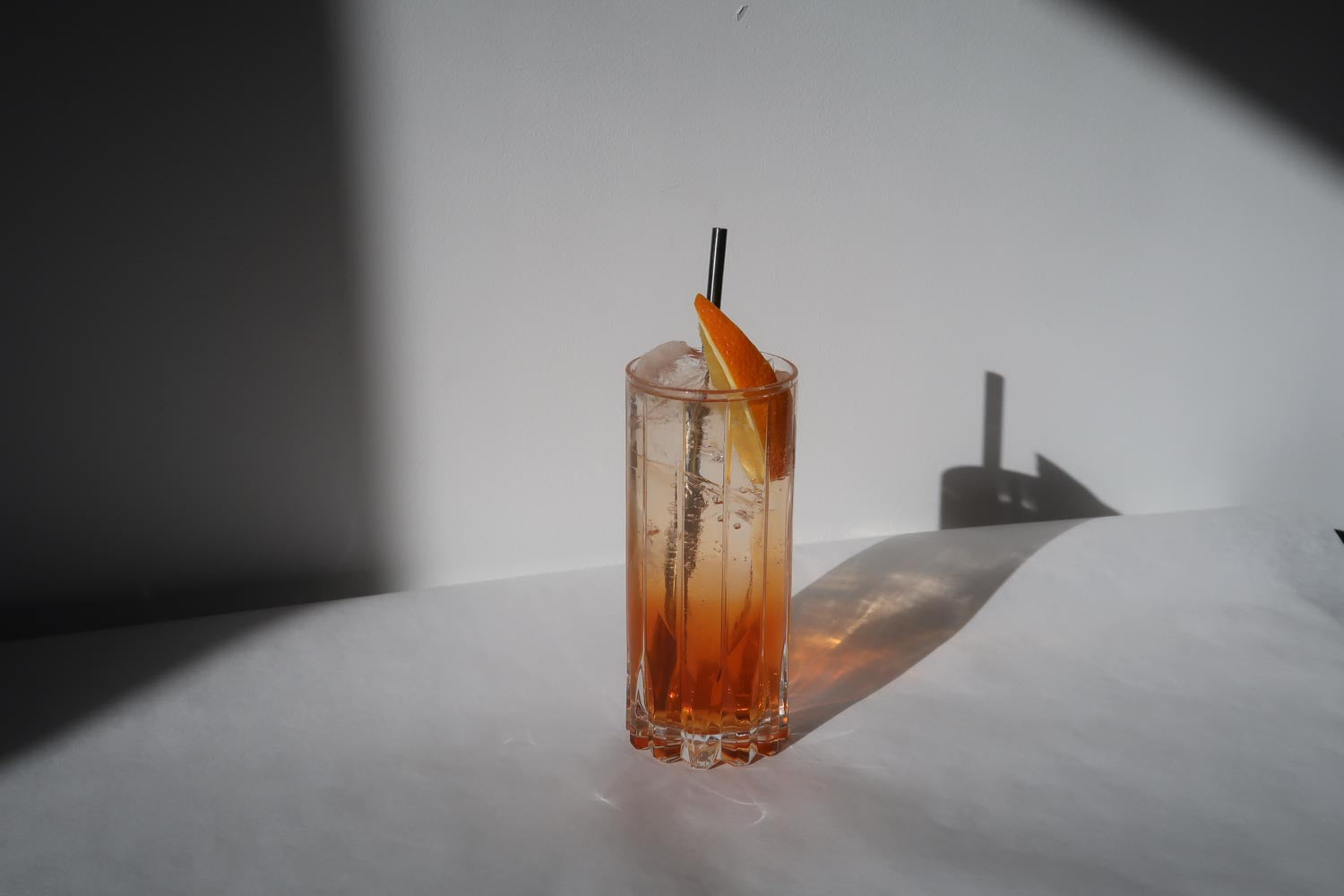We're exploring twelve seasonally-inspired cocktail recipes this year alongside our candle subscription with writer, historian, and cocktail creative Al Culliton.
Simple & Non-alcoholic Versions: Here
New to cocktail making?
Read our Drinks101 post first.
June might just be the most glorious month of the year. While chilly early mornings and evenings persist in April and May, June brings us perfect peak summer. That’s probably because it’s still spring. In the dark of winter, when we think of an ideal summer’s day, we don’t think of sweltering days in July and August, but rather about June’s perfect balance between spring and summer. In our modern world, June often marks the beginning of a more relaxed season, ideally with some time off in store. Two of our Keap theme words this month — swimming and exercising — fit into June perfectly. Finally, the rush of spring waters lets up and we can swim in the rivers again. And because it’s not too humid or hot yet, it’s the ideal temperature for getting outside and being active, whether you’re going for a run, kayaking, or playing softball.

June: Threshing + Baling; Source: National Gallery
If you’ve been reading along each month, you’ll know that we’re looking to the Labors of the Month, a cycle found in medieval calendars, for inspiration. The third Keap theme word for this month is “adapting.” Adapting for us might mean a looser routine or more time away from home base, but for the people of medieval Europe, June was a time of adaptation to a new pace. Unfortunately for the medieval folk (and for farmers today!), it was the opposite of our modern summers full of leisure and vacation. For them, the pace was quickening, as the agricultural year was ramping up to full production mode.
The most common labor depicted for June is haying — the mowing, raking, drying, and baling of tall grass to be stored for animal fodder. This was a massive undertaking in a wholly agricultural society and was vital in keeping livestock fed year-round, especially during the cold weather months. Another activity often depicted as a June labor is weeding around the crops planted in the springtime, which require constant upkeep. Some calendars also feature sheep shearing in June. This one speaks to the welcome change in the weather at this time of year. The sheep don’t need their winter coats to sleep outside overnight now that summer is here, so shepherds would harvest their wool and spin it into yarn to warm themselves when autumn rolled around again. In every one of these, the object is to ensure that you take what you need from summer’s bounty to sustain yourself for the rest of the year.

June: Sheep Shearing; Source: Pinterest
Fast forward to another agricultural society, eighteenth-century New England, and we see another tradition of preserving the abundance of the summer months: shrubs, a method of prolonging the life of fresh fruits through the use of the time-honored preserving agents vinegar and sugar. Household manuals from this period are full of recipes for various shrubs made with a variety of fruits. If you’ve never made a shrub before, this is your chance!
For this month’s cocktail — named Junius after the Latin word for June — we’re putting a strawberry-rhubarb shrub front and center. The drink itself is a hybrid, just as June is a mix of spring and summer. We’re crossing a classic Collins template with an Americano. A traditional Collins — i.e., a Tom Collins — takes spirit (gin) and adds sweet (sugar) and sour (lemon) elements, before giving it a shake and topping the mixture with soda. The Americano is an aperitivo highball that features a bittersweet flavor profile (thanks to Campari and sweet vermouth) and is topped with soda.

For our Junius, I opted for cognac as the base. It’s a little-known fact that brandy is a great option for refreshing summer drinks. VS (aged 2 years) and VSOP (aged 4 years) cognac expressions are still young and lively, and they go perfectly with fruit flavors. We’re imparting a sour element by using our shrub instead of citrus. This also means that the mixture doesn’t have to be shaken, because the shrub integrates with the other ingredients easily. Gentian liqueur comes in to give us a bitter undertone (inspired by the Americano), and tonic further bolsters that flavor with quinine. This drink, to me, feels like the transition between late spring and early summer in a glass.

Junius
A strawberry-rhubarb Collins-Americano hybrid.
- 1½ oz. cognac
- ¾ oz. strawberry-rhubarb shrub
- ½ oz. gentian liqueur
- Tonic, to top
- Orange wedge, for garnish
Pour cognac, shrub, and gentian liqueur into a highball or Collins glass and stir briefly. Add ice to fill and top with a couple of ounces of tonic water. Tuck an orange wedge into the glass and serve with a straw.
STRAWBERRY-RHUBARB SHRUB
Slice 2 medium stalks of rhubarb crosswise until you’ve got 1 cup. Slice 1½ cups strawberries. Set fruit aside. Mix together 1¼ cups sugar and ¼ teaspoon kosher salt in a small bowl. In a large nonreactive jar or container with a lid, layer the rhubarb and strawberries evenly with the sugar mixture. Seal the jar and turn it upside down a couple of times. Now, let it sit on the counter for a few hours. (If it’s hot out, just an hour or so will do! The juices are drawn out of the rhubarb more quickly at higher temps.) You want to see a fair amount of liquid in the jar at this point. Put your jar into the fridge overnight. Twenty-four hours after you first combined the sugar mixture with the fruit, add 1 cup red wine vinegar. After adding the vinegar, leave it at room temp for a few hours, then taste it to see if it needs more vinegar (up to ¼ cup more). Turn the jar upside down a couple times, and put it back in the fridge for a minimum of 24 hours. If you can, try to wait longer, up to two days more, so the flavors can develop further. When it’s ready, strain out the solids and store in an airtight container in the fridge; it will keep well for several months.

Drinks 101
What's a Shrub?
A note on shrubs: Shrubs were a very common method for preserving summer fruits, much like making a jam or jelly. Through the use of both sugar and vinegar, the bounty of summer is captured in a bottle. During the eighteenth and early nineteenth centuries, recipes for all kinds of shrubs popped up in many recipe books. At the time, water wasn’t very safe to drink, and adding vinegar and sugar both preserved the fruit and made the water in the shrub potable. The method you see in our strawberry-rhubarb shrub recipe can be adapted to many different types of stone fruits, berries, and tropical fruits. You can also have fun pairing different vinegars with whatever fruit you’re using. Personally, I like red wine vinegar for red fruits; white wine vinegar for peaches, apricots, and nectarines; and apple cider vinegar for blueberries!

This month’s simpler recipe
Looking for a simpler twist or a non-alcoholic option?
- Simple recipe: In a cocktail shaker, muddle 2 strawberries with ¾ oz. simple syrup. Add ¾ oz. lemon juice and 1½ oz. cognac. Add plenty of ice and shake for 15 seconds. Fine strain into a Collins glass, add fresh ice, and top with soda. Garnish with a lemon slice.
- Non-alcoholic version: In a cocktail shaker, muddle 2 strawberries with 1 oz. simple syrup. Add 1 oz. lemon juice. Add plenty of ice and shake for 15 seconds. Fine strain into a Collins glass, add fresh ice, and top with soda. Garnish with a lemon slice.














